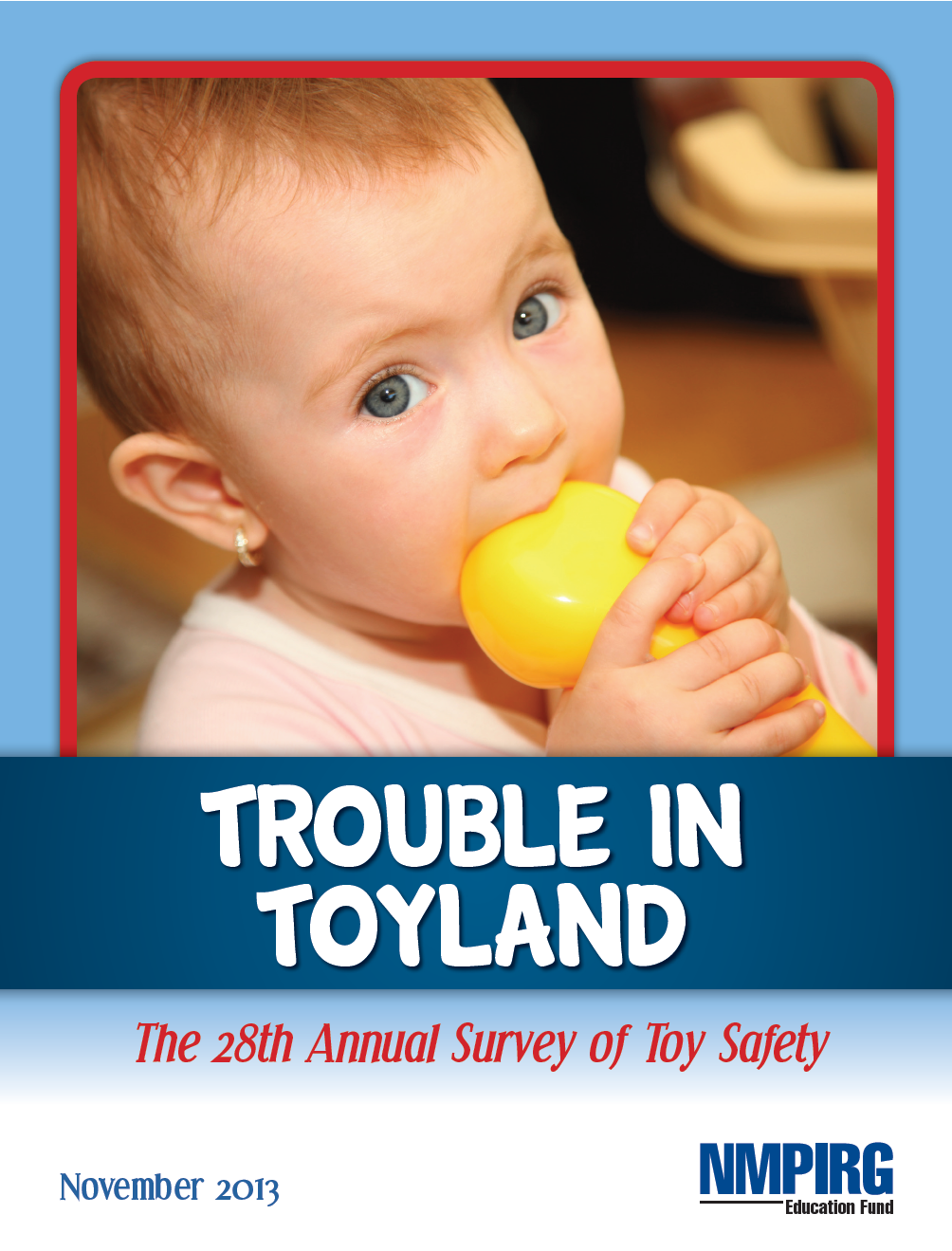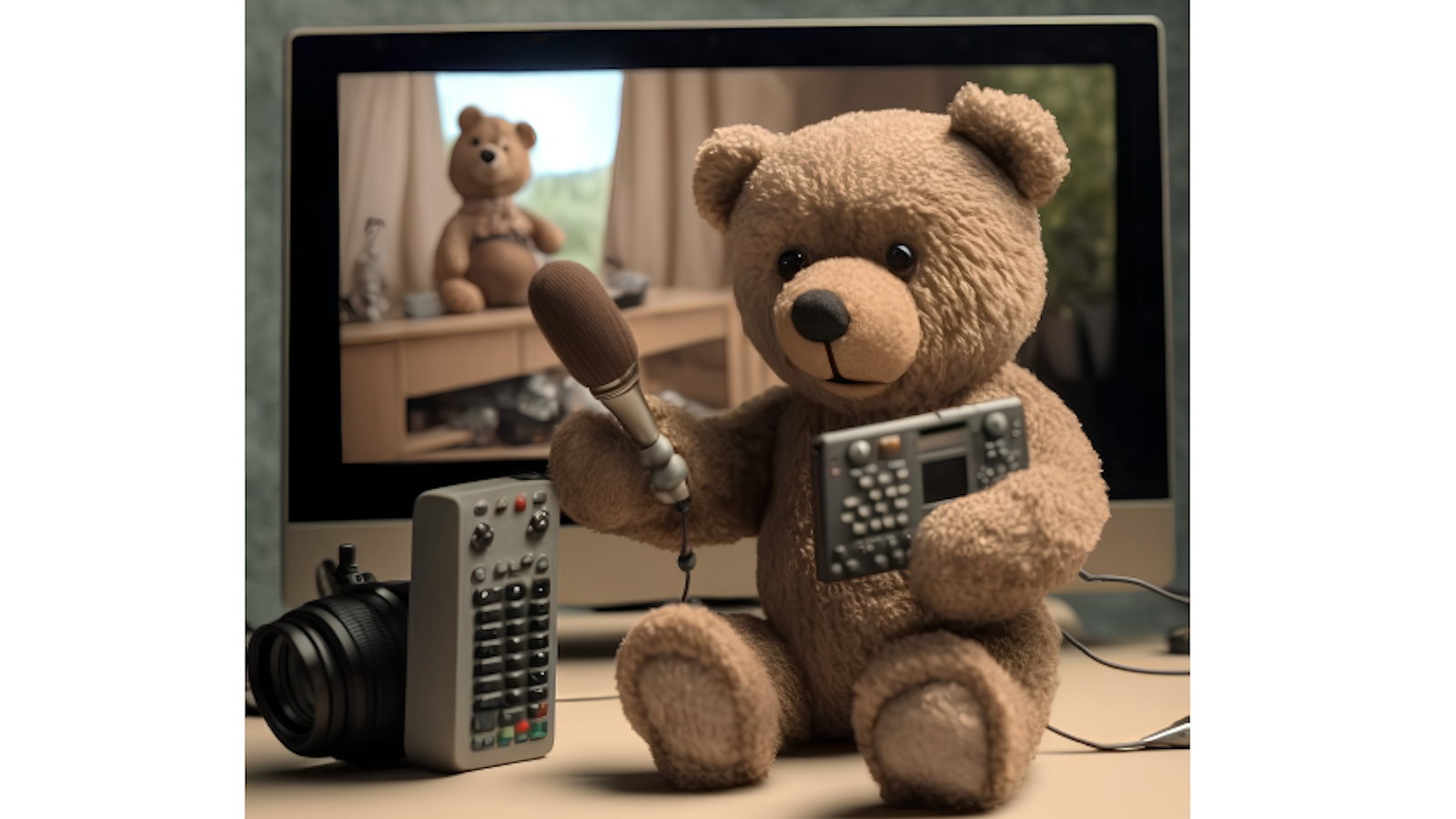
Trouble in Toyland 2013
The 28th Annual Survey of Toy Safety
The 2013 Trouble in Toyland report is the 28th annual New Mexico Public Interest Research Group survey of toy safety. In this report, NMPIRG provides safety guidelines for consumers when purchasing toys for small children and provides examples of toys currently on store shelves that may pose potential safety hazards.

Downloads
NMPIRG Education Fund
EXECUTIVE SUMMARY
The 2013 Trouble in Toyland report is the 28th annual New Mexico Public Interest Research Group (PIRG) survey of toy safety. In this report, NMPIRG provides safety guidelines for consumers when purchasing toys for small children and provides examples of toys currently on store shelves that may pose potential safety hazards.
Over the past twenty-eight years, our report has identified hazards in toys and children’s products that could cause acute injuries, from choking hazards from toys with small parts, to strangulation hazards from cords on pull toys, to laceration hazards from edges that are too sharp, to toxic hazards posed by chemicals in toys. Our report has led to more than 150 recalls and other regulatory actions over the years, and has helped educate the public and policymakers on the need for stronger public health and consumer safety standards to protect children from unsafe products. This report continues to help keep children – particularly babies and toddlers – safe, as the majority of all injuries happen to children in the 0-2 age range.
The enactment of the Consumer Product Safety Improvement Act (CPSIA) of 2008 made great strides in toy safety and strengthened the ability of the Consumer Product Safety Commission (CPSC) to protect consumers, including the littlest consumers—children. Although policymakers delayed implementation of its most stringent lead standard rules and enacted some narrow exceptions in 2011, on the whole the law has been protected from attempts to undermine it. However, we remain vigilant as a variety of regulatory threats to the CPSC’s tools and authority remain under consideration by policymakers.
We Looked For Common Hazards in Toys
We visited numerous national toy stores, malls and dollar stores in September, October, and November 2013 to identify potentially dangerous toys. Our researchers examined the CPSC notices of recalls and other regulatory actions to identify trends in toy safety. Our investigation is focused on toys that posed a potential toxic, choking, strangulation or noise hazard.
Our Key Findings Include:
Lead Continues to be a Hazard in Toys
Exposure to lead can affect almost every organ and system in the human body, especially the central nervous system. Lead is especially toxic to the brains of young children and can cause permanent mental and developmental impairments; it has no business being in children’s products.
The current federal legal lead standard is 100 parts per million (ppm), though the American Academy of Pediatrics recommends a lead limit of 40 ppm. We found two toys that violate the CPSC’s lead standard of 100 ppm. Most notably, the Captain America Soft Shield, for ages two and up, was found to contain 29 times the standard (2900 ppm) for lead.
Other Toxics in Toys
The current federal legal standard limits six kinds of phthalates to 1,000 ppm, and limits the amount of antimony and arsenic, cadmium and other elements that can leach out of toys. We found toxic chemicals including phthalates, antimony, and cadmium. The Ninja Turtles Pencil Case was found to contain 150,000 ppm of one of six phthalates banned from toys, as well as excessive levels (600 ppm) of the toxic metal cadmium.
Choking Hazards
Choking – on small toy parts, on small balls, on marbles and on balloons – continues to be the major cause of toy-related deaths and injuries. Between 2001 and 2012, more than 90 children died from choking incidents.
This year we found several toys that contained small parts or “near small part” toys. The toys containing small parts contained improper labels and might be mistakenly purchased for children under 3. The toys containing near small parts support our argument that the small parts test should be made more protective by making the test cylinder larger.
We also found some toy foods including both near small parts and other rounded ball-like foods that would fail the small ball test although they are technically subject to the less-stringent small parts test. Toy foods pose a special hazard, because they look to small children like something that should be eaten.
Magnets
Magnet toys made with neodymium iron boron magnets, such as the Buckyball magnets that are the subject of a CPSC court action, are still available and continue to cause accidents. CPSC staff have estimated that between 2009 and 2011 there were 1,700 emergency room cases nationwide involving the ingestion of high powered magnets. More than 70% of these cases involved children between the ages of 4 and 12.
We also found ellipsoid toy magnets that nearly fit in the small parts cylinder, and are classified as a novelty “finger-fidget” toy. These magnets are smooth and shiny and sold in pairs; striking them together causes them to vibrate and produce a singing sound, making them appealing to children. CPSC has reported gastroenterological injuries associated with ellipsoid magnets. If the magnet had fit in the small parts test cylinder, it would be banned for sale to children under 14. These, instead, were labeled “8 and up.”
Noisy Toys
Research has shown that a third of Americans with hearing loss can attribute it in part to noise. The third National Health and Nutrition Examination Survey showed that one in five U.S. children will have some degree of hearing loss by the time they reach age 12. This may be in part due to many children using toys and other children’s products such as music players that emit loud sounds. The National Institute on Deafness and Other Communication Disorders advises that prolonged exposure to noise above 85 decibels will cause gradual hearing loss in any age range. Toys that are intended to be held close to the ear are not to exceed 65 decibels. Toys that held within close range (in a lap or on a table) are not to exceed 85 decibels.
We found toys on store shelves that exceeded the limit of 65 decibels for toys held close to the ear. The Chat & Count Smart Phone, for example, produces sound measuring higher than 85 decibels when measured at 2.5 centimeters, and children may hold such toys pressed up against the ear.
Recommendations for Policymakers
- Policymakers must ensure that the Consumer Product Safety Commission (CPSC) is given the resources it needs to effectively protect consumers.
- Policymakers must also continue vigorous oversight of implementation and enforcement of the law.
- Policymakers should require manufacturers to provide all hazard and health-impact information to the state and federal government so agencies can begin to assess the thousands of chemicals currently on the market for which little or inadequate data are available.
- There is overwhelming evidence showing that the Toxic Substances Control Act is failing our most vulnerable consumers: pregnant women, babies and children. Policymakers should take steps to ensure that the American people are better protected from toxics in products.
- Policymakers should reject well-funded special interest efforts to weaken the ability of regulatory agencies to conduct rulemakings or enforce rules designed to protect public health and safety.
For the Consumer Product Safety Commission
- The CPSC should continue to vigorously enforce the current (100 ppm) lead limits in toys. The CPSC should also move to using the more stringent lead standard of 40 ppm recommended by the American Academy of Pediatrics.
- The CPSC should continue to vigorously enforce the current (1000 ppm) limit on phthalates in toys, make the interim ban on DINP, DIDP and DNOP permanent, and expand the ban on all six to include all products for children 12 and under.
- The CPSC should ban from toys any chemicals that may to provoke cancer, change genetic information or harm reproduction, so-called CMR (Carcinogenic, Mutagenic or toxic for Reproduction), as well as fragrances which have a strong allergenic potential.
- The CPSC should review and, where necessary, expand its definition of a “small part” or “small toy” to include parts and toys that are larger than the current standard, but have been shown to pose a choking hazard to children. In particular, the CPSC should examine whether rounded toys that are not balls and toy food shaped like balls should be regulated under the more stringent small ball test.
- The CPSC should proceed with rulemaking to regulate high powered magnets.
- The CPSC must continue to ensure that new third-party testing programs meet CPSIA standards. As the CPSC continues to implement its new publicly accessible toy and other product incident database at www.saferproducts.gov, it must ensure that it provides the information consumers need to make informed choices in the marketplace.
For Consumers
Be vigilant this holiday season, and remember:
- The CPSC does not test all toys, and not all toys on store shelves meet CPSC standards.
There is no comprehensive list of potentially hazardous toys. Examine toys carefully for potential dangers before you make a purchase. Shop with U.S. PIRG’s Toy Safety Tips available at www.ToySafetyTips.org and on our website, www.uspirg.org.
Parents should continue to be vigilant about metals in toys as they may contain lead or cadmium above the mandatory safety limits. The Centers for Disease Control (CDC) recommends that all children be screened for exposure to lead. A simple and inexpensive blood test can determine whether or not a child has a dangerous level of lead in his or her body. The test can be obtained through a physician or public health agency. - Report unsafe toys or toy-related injuries to the CPSC at www.cpsc.gov and www.saferproducts.gov or call the CPSC at 1-800-638-2772.
Topics
Find Out More


5 steps you can take to protect your privacy now

Too much to recall
